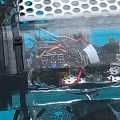ICYMI: Highlights from the week that was June 17 – June 23, 2018
No one can keep up with everything, so let us do it for you. We’ll gather the top Smithsonian stories from across the country and around the world each week so you’ll never be at a loss for conversation around the water cooler.
This week, we saw the world through the lenses of both art and science as we looked into the past, experienced the present and peered beyond the grave.

‘Daguerreotypes’ at the National Portrait Gallery
Blouin ArtInfo, June 19

“Thomas Buchanan Read,”1850, Marcus Aurelius. Root Half-plate daguerreotype
(National Portrait Gallery Smithsonian Institution; gift of Miss Eunice Chambers)
“Daguerreotypes: Five Decades of Collecting” displays a variety of small-scale, one-of-a-kind portraits of influential early Americans. The exhibit, on view through June 2, 2019, explores the first commercially viable form of photography.
Included will be portraits of such iconic figures as activist and reformer Dorothea Dix, entrepreneur and showman P. T. Barnum with Tom Thumb, the Seneca leader Blacksnake, US Navy Commodore Matthew C. Perry, and artist Alfred Waud.
The exhibition is put on in celebration of the Portrait Gallery’s golden anniversary. The portrait gallery’s rich collection of more than 23,000 objects include some of the country’s most important photographic portraits. Glass-plate negatives by Mathew Brady and the acclaimed 2017 acquisition of an 1843 daguerreotype likeness of President John Quincy Adams by artist Philip Haas, are among the many highlights of the gallery’s illustrious acquisitions. Read more from Blouin ArtInfo.
Trevor Paglen lets you view the world as the machines see it
Ahead of his retrospective at Washington, DC’s Smithsonian American Art Museum, the artist discusses his interest in the social and political implications of technologies, including mass surveillance systems and artificial intelligence
The Art Newspaper, June 20

Trevor Paglen, Reaper Drone (Indian Springs, NV; Distance ~ 2 miles) (2010) C-print and photo: Trevor Paglen. Image courtesy of the artist; Metro Pictures, New York; Altman Siegel Gallery, San Francisco
It is a busy year for Trevor Paglen. The Berlin-based US artist, who was awarded a $625,000 MacArthur genius grant last October, is not resting on his laurels. This month, Trevor Paglen: Sites Unseen (21 June-6 January 2019) opens at the Smithsonian American Art Museum in Washington, DC—his first major career retrospective and one of the biggest solo shows the museum has ever given to a contemporary artist. The exhibition includes works from throughout his career, from his atmospheric photographs of military installations, spy satellites and underwater internet cables, to his sculptures that give a physical presence to abstract or secret ideas, such as a cube made from irradiated glass in Fukushima or the talisman-like “challenge coins” circulated among the intelligence community. More recently, Paglen has started to examine the often surrealistic vision systems created for artificial intelligence (AI) and he is also collaborating with the Kronos Quartet on a performance that mixes their music with computer visualisations. And this autumn, he is literally launching a sculpture into space on a Falcon 9 rocket. We spoke with the artist from his studio in Berlin. Read more from Helen Stoilas for The Art Newspaper.
Civil War Battlefield ‘Limb Pit’ Reveals Work Of Combat Surgeons
NPR, June 20

A pit of amputated limbs and two nearly complete skeletons that date back to the Civil War were discovered at Manassas National Battlefield Park in Virginia. Scientists at the Smithsonian Institution’s National Museum of Natural History have been analyzing the bones to learn more about them and to whom they may have belonged.
Meredith Rizzo/NPR
Scientists have uncovered a pit of human bones at a Civil War battlefield in Virginia. The remains are the amputated limbs of wounded Union soldiers.
It’s the first “limb pit” from a Civil War battlefield to be excavated, and experts say it opens a new window on what is often overlooked in Civil War history: the aftermath of battle, the agony of survivors and the trials of early combat surgeons.
The bones first surfaced in 2014 when a utility crew was digging at the Manassas National Battlefield Park. The National Park Service runs the site, and fortunately it had an archaeologist and Civil War expert on hand: Brandon Bies.
Bies says at first they weren’t sure what they had. “Just pieces of bone,” says Bies, who is now superintendent of the Manassas site. But over time more bones surfaced. The Park Service sent them to some of the world’s leading forensic anthropologists at the Smithsonian’s National Museum of Natural History in Washington, D.C. Read more from Christopher Joyce for NPR’s “Morning Edition.”
The Smithsonian Folklife Festival returns with a focus on Armenia, Catalonia, and a resurrection of the Sisterfire concerts
The Washington Post, June 21

This year’s Folklife Festival will look just like this, only with different signs and a bunch of Catalans building human towers. (Francisco Guerra (Smithsonian Institution)
The Smithsonian Folklife Festival returns with a focus on Armenia, Catalonia, and a resurrection of the Sisterfire concerts Read more from Kristen Page-Kirby for The Washington Post Express.
Wakanda Comes to Washington: Museum Acquires ‘Black Panther’ Items
NBC4-Washington, June 21

Shutterstock photo
Wakanda is coming to Washington.
Items from the box-office hit “Black Panther” are coming to the National Museum of African American History and Culture, the museum announced Wednesday.
The superhero costume Chadwick Boseman wore as the Black Panther will be on display, as well as scripts used by the crew and behind-the-scenes photos. Read more from Erica Jones for NBC4.
Posted: 24 June 2018







